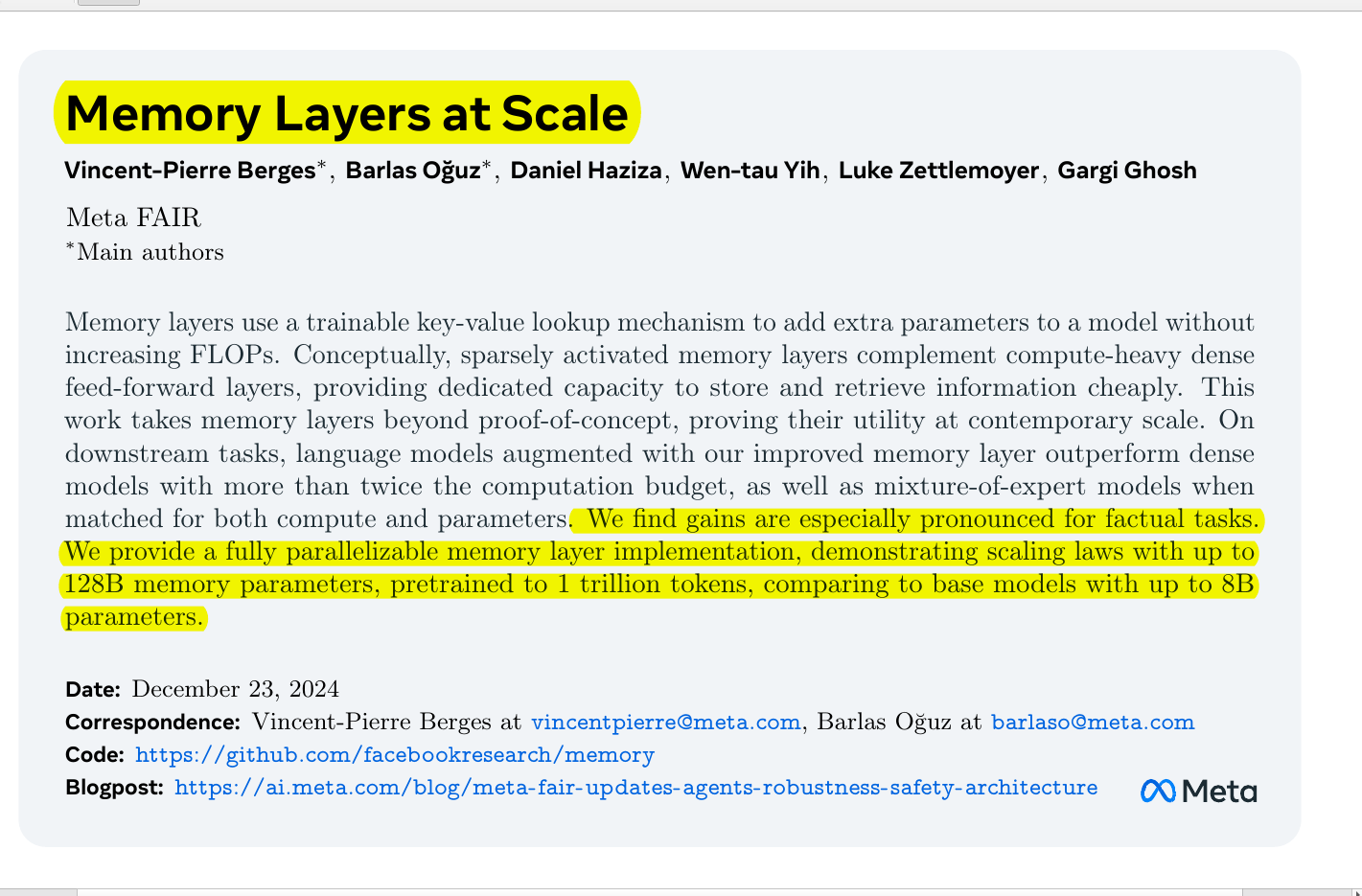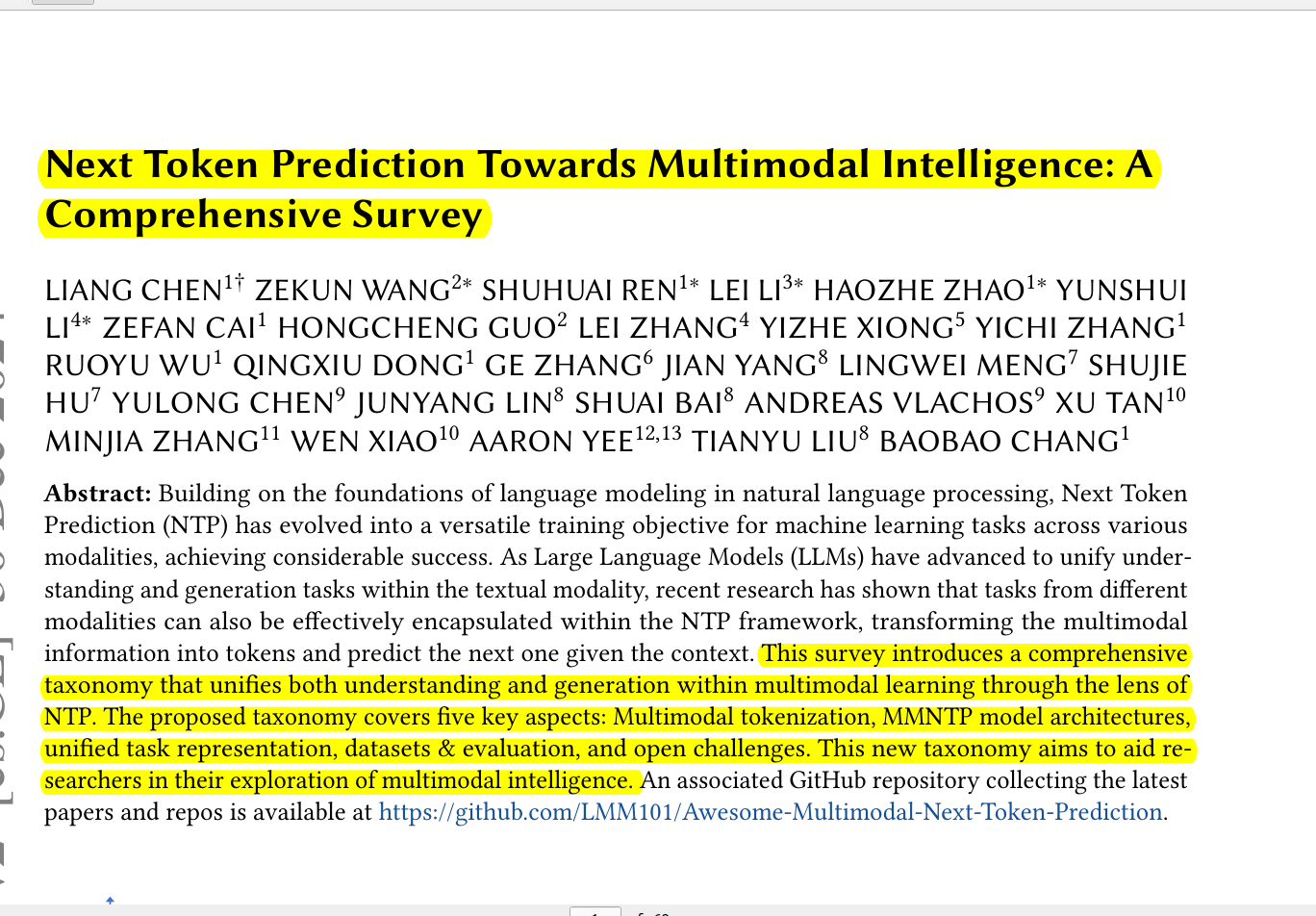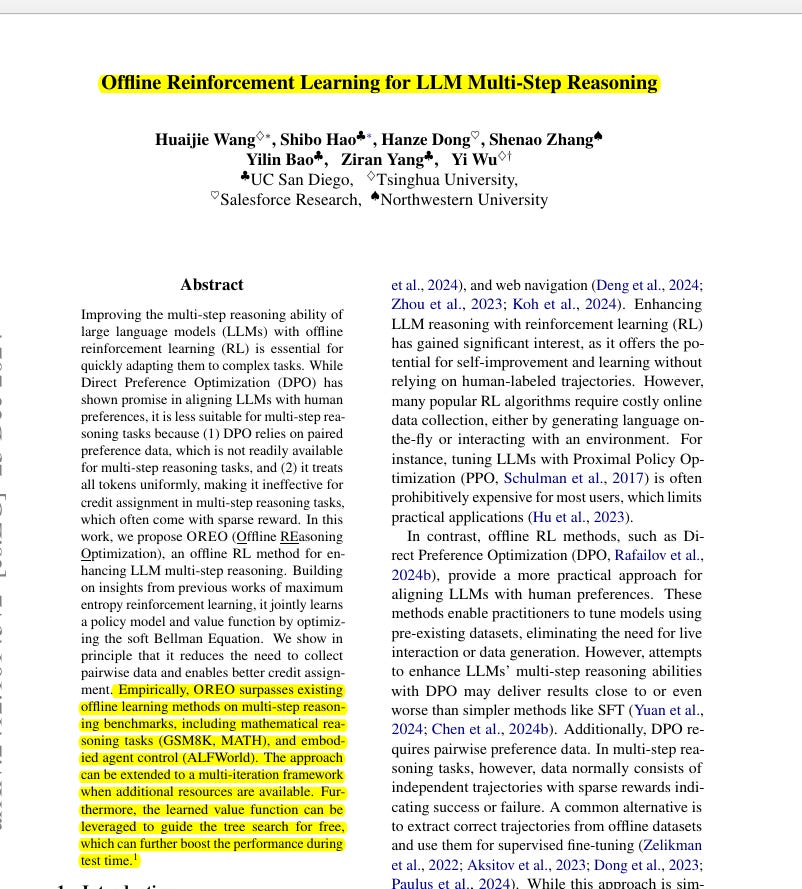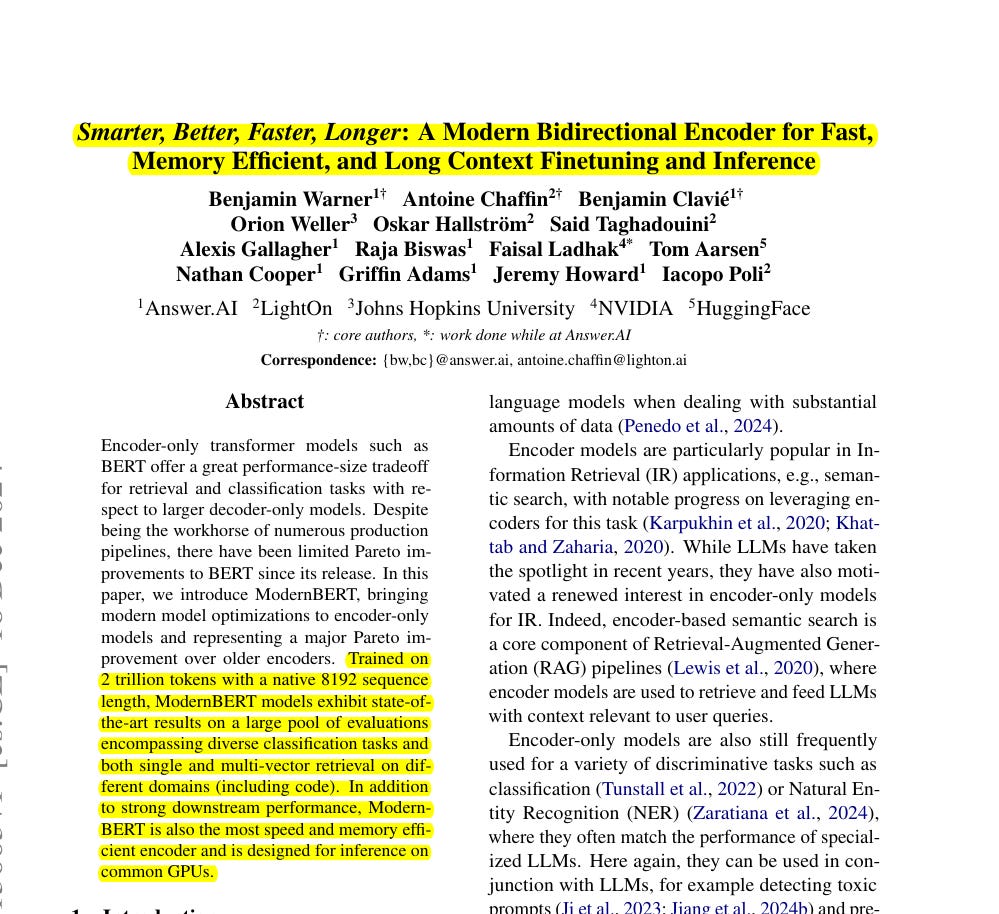TOP Papers of last week of Dec-2024
The most discussed AI paper from the last week.
Entire Paper List will not be shown in your email - read it on the web here.
Some of the most discussed AI papers from last week of Dec-2024:
Don’t Do RAG: When Cache-Augmented Generation is All You Need for Knowledge Tasks
CLIP-UP: CLIP-Based Unanswerable Problem Detection for Visual Question Answering
FlashInfer: Efficient and Customizable Attention Engine for LLM Inference Serving
HumanEval Pro and MBPP Pro: Evaluating Large Language Models on Self-invoking Code Generation
Improving Factuality with Explicit Working Memory
Infinity: Scaling Bitwise AutoRegressive Modeling for High-Resolution Image Synthesis
KaLM-Embedding: Superior Training Data Brings A Stronger Embedding Model
LMFusion: Adapting Pretrained Language Models for Multimodal Generation
LatentSync: Audio Conditioned Latent Diffusion Models for Lip Sync
MedCoT: Medical Chain of Thought via Hierarchical Expert
Memory Layers at Scale
Next Token Prediction Towards Multimodal Intelligence: A Comprehensive Survey
Offline Reinforcement Learning for LLM Multi-Step Reasoning
Preference Discerning with LLM-Enhanced Generative Retrieval
Smarter, Better, Faster, Longer: A Modern Bidirectional Encoder for Fast, Memory Efficient, and Long Context Finetuning and Inference
The Prompt Report: A Systematic Survey of Prompting Techniques
When to Speak, When to Abstain: Contrastive Decoding with Abstention
Don’t Do RAG: When Cache-Augmented Generation is All You Need for Knowledge Tasks
Paper - https://arxiv.org/abs/2412.15605v1
Precomputed key-value caches make knowledge retrieval 40x faster than traditional RAG.
Cache-augmented generation replaces traditional retrieval-augmented generation by preloading documents and precomputing key-value caches, making knowledge tasks faster and more accurate.
🤔 Original Problem:
Traditional RAG systems suffer from retrieval latency, errors in document selection, and complex system architecture that requires careful tuning and maintenance.
🔧 Solution in this Paper:
→ The paper introduces Cache-Augmented Generation (CAG), which preloads all relevant documents into LLM's memory before inference.
→ CAG precomputes key-value caches from documents, storing them for future use rather than retrieving during runtime.
→ The system operates in three phases: external knowledge preloading, inference with cached context, and efficient cache reset.
💡 Key Insights:
→ Eliminating retrieval during inference dramatically reduces response time and system complexity.
→ Preloading context enables holistic understanding across all documents.
→ CAG works best when document collections fit within LLM context windows.
📊 Results:
→ CAG achieves highest BERT-Score (0.7759) on HotPotQA, outperforming both sparse and dense RAG systems.
→ Generation time reduced from 94.34s to 2.32s on large datasets.
→ Consistent performance improvement across both SQuAD and HotPotQA benchmarks.
🗞️ "CLIP-UP: CLIP-Based Unanswerable Problem Detection for Visual Question Answering"
https://arxiv.org/abs/2501.01371
CLIP-UP enables Vision-Language Models to identify and handle unanswerable visual questions through a lightweight training approach that preserves original model capabilities.
🤔 Original Problem:
Vision-Language Models often provide wrong answers to unanswerable visual questions, like asking about objects not present in images, reducing their reliability.
🔧 Solution in this Paper:
→ CLIP-UP extracts question-image alignment information through correlation vectors using CLIP embeddings
→ It projects these vectors into the model's feature space using lightweight trainable layers
→ A Mixture-of-Experts approach handles different types of unanswerable questions through specialized projections
→ The method only trains projection layers while keeping original model weights frozen
→ Simple rule-based classification determines when to activate the new embedding vector
💡 Key Insights:
→ Global alignment information from CLIP helps detect unanswerability
→ Lightweight training can effectively add new capabilities without full model fine-tuning
→ Different unanswerability types benefit from specialized expert projections
📊 Results:
→ Achieves state-of-the-art results on MM-UPD benchmark
→ Maintains original model performance on standard tasks
→ Requires only 12.6M parameters for projection layers
🗞️ "FlashInfer: Efficient and Customizable Attention Engine for LLM Inference Serving"
https://arxiv.org/abs/2501.01005
FlashInfer makes LLM serving faster by smartly managing memory and adapting to different workloads.
FlashInfer introduces a unified attention engine that optimizes LLM serving through customizable templates, block-sparse storage, and dynamic scheduling, significantly improving inference performance.
29-69% inter-token-latency reduction vs Triton backend
🤔 Original Problem:
LLM serving faces challenges with diverse workload patterns, varying input lengths, and hardware-specific optimizations. Current solutions implement specialized attention mechanisms, leading to maintenance overhead and potential inefficiencies.
🔧 Solution in this Paper:
→ FlashInfer uses block-sparse format to handle KV-cache storage heterogeneity, enabling efficient memory access and reduced redundancy
→ A customizable attention template supports various attention variants through JIT compilation, allowing rapid adaptation to different configurations
→ Dynamic load-balanced scheduling algorithm adjusts to input changes while maintaining CUDAGraph compatibility
→ Integration with major serving frameworks like SGLang, vLLM and MLC-Engine ensures practical applicability
🎯 Key Insights:
→ Block-sparse format with flexible block sizes effectively unifies diverse KV-cache patterns
→ JIT compilation enables customization without performance overhead
→ Load-balanced scheduling crucial for handling variable sequence lengths
→ Composable formats improve memory efficiency for shared prefixes
📊 Results:
→ 29-69% inter-token-latency reduction vs Triton backend
→ 28-30% latency reduction for long-context inference
→ 13-17% speedup for parallel generation
→ Significant bandwidth and FLOPs utilization improvements
🗞️ "HumanEval Pro and MBPP Pro: Evaluating Large Language Models on Self-invoking Code Generation"
https://arxiv.org/abs/2412.21199v2
LLMs struggle to reuse their own generated code for solving complex problems, leading to significant performance gaps in real-world programming scenarios.
🤔 Original Problem:
→ Current code generation benchmarks only test isolated function creation, not how well LLMs can use their own code to solve harder problems.
→ Real programming requires understanding and reusing existing code, which LLMs haven't been properly evaluated on.
🔧 Solution in this Paper:
→ Introduces "self-invoking code generation" - LLMs must solve a base problem then use that solution for a more complex related problem.
→ Creates three new benchmarks: HumanEval Pro, MBPP Pro, and BigCodeBench-Lite Pro to test this capability.
→ Uses systematic method to construct self-invoking problems by building on existing datasets.
💡 Key Insights:
→ Most LLMs show 10-15% performance drop on self-invoking tasks compared to regular code generation
→ Instruction-tuned models have less improvement over base models on self-invoking tasks
→ Large open-source LLMs perform similarly to proprietary ones on these tasks
→ AssertionErrors and NameErrors are the main failure modes
📊 Results:
→ O1-mini: 96.2% on HumanEval but only 76.2% on HumanEval Pro
→ DeepseekCoder-V2-instruct achieves 77.4% on HumanEval Pro, beating proprietary LLMs
→ Chain-of-Thought prompting improves performance by 3-5% on self-invoking tasks
🗞️ "Improving Factuality with Explicit Working Memory"
https://arxiv.org/abs/2412.18069
Memory-augmented LLMs that can pause, verify facts, and correct themselves on the fly
LLMs often generate incorrect facts. This paper introduces Explicit Working Memory (Ewe) that actively monitors and corrects factual errors during text generation.
🤔 Original Problem:
→ LLMs frequently hallucinate facts when generating long-form text
→ Current retrieval methods (RAG) have limitations in maintaining factual accuracy throughout generation
🛠️ Solution in this Paper:
→ Ewe introduces a working memory system that stores knowledge from retrieved passages in multiple memory units
→ The system pauses generation periodically to check facts and refresh memory with new relevant information
→ When factual errors are detected, Ewe backtracks, updates memory with correct information, and regenerates text
→ Memory units process different passages in parallel, allowing flexible incorporation of various knowledge sources
💡 Key Insights:
→ Shorter memory units (128 tokens) perform better than longer ones
→ Supporting passages are more effective than instruction-based feedback
→ Combining C4 and Wikipedia knowledge improves factual accuracy
→ Intermediate intervals for memory refresh show optimal results
📊 Results:
→ Improved VeriScore (factuality metric) by 2-10 points absolute across four datasets
→ Maintained helpfulness comparable to base model
→ Outperformed all baseline methods including standard RAG and Chain-of-Verification
🗞️ "Infinity: Scaling Bitwise AutoRegressive Modeling for High-Resolution Image Synthesis"
https://arxiv.org/abs/2412.04431
Bits beat pixels: A new way to teach AI about images
Infinity turns every image into bits, making AI art generation faster and better than ever
Infinity introduces a bitwise visual autoregressive model that transforms high-resolution image generation by using infinite vocabulary tokenization and self-correction mechanisms.
🤖 Original Problem:
Current autoregressive models struggle with high-resolution image generation due to limited vocabulary size, poor reconstruction quality, and train-test discrepancy issues.
🔧 Solution in this Paper:
→ Introduces bitwise modeling framework with three key components: bitwise multi-scale residual quantizer, infinite-vocabulary classifier, and bitwise self-correction
→ Scales tokenizer vocabulary to 2^64 while reducing memory by 99.95% through dimension-independent bitwise quantization
→ Implements parallel binary classifiers instead of conventional classifier to handle extremely large vocabulary
→ Uses random bit flipping and re-quantization for self-correction during training to address prediction errors
💡 Key Insights:
→ Bitwise tokenization enables nearly infinite vocabulary while maintaining low memory usage
→ Parallel binary classification is more efficient than conventional methods for large vocabularies
→ Self-correction mechanism significantly reduces train-test discrepancy
→ Progressive training strategy improves generation quality across resolutions
📊 Results:
→ Generates 1024×1024 images 2.6× faster than SD3-Medium (0.8s vs 2.1s)
→ Improves GenEval score from 0.62 to 0.73 compared to SD3-Medium
→ Achieves 66% win rate in human evaluation
→ Reduces memory usage by 99.95% compared to conventional classifiers
🗞️ "KaLM-Embedding: Superior Training Data Brings A Stronger Embedding Model"
https://arxiv.org/abs/2501.01028
Clean data beats complex architecture for better multilingual embeddings
KaLM-Embedding achieves state-of-the-art performance in multilingual text embedding by focusing on superior training data quality and innovative data processing techniques.
🤔 Original Problem:
→ Current embedding models often overlook training data quality, leading to suboptimal performance in multilingual retrieval tasks
→ False negatives in fine-tuning data introduce noise in representation learning
🛠️ Solution in this Paper:
→ Leverages Qwen2-0.5B as base architecture with mean pooling and 512 token limit
→ Implements persona-based synthetic data generation using LLMs to create diverse training examples
→ Uses ranking consistency filtering to remove low-quality samples and reduce noise
→ Applies semi-homogeneous task batch sampling to balance training efficacy
→ Incorporates over 20 categories of pre-training data and 70 categories of fine-tuning data
💡 Key Insights:
→ Data quality proves more crucial than model architecture
→ Task instructions significantly enhance model performance
→ Pre-training impact is relatively minor compared to previous studies
📊 Results:
→ Outperforms other models under 1B parameters on MTEB benchmark
→ Achieves 64.13% on Chinese MTEB and 64.94% on English MTEB
→ Shows strong multilingual capabilities despite primary training on Chinese and English
🗞️ "LMFusion: Adapting Pretrained Language Models for Multimodal Generation"
https://arxiv.org/abs/2412.15188
Teaching language models to handle images without messing up their text abilities
LMFusion enables text-only LLMs to understand and generate both text and images while preserving their original language capabilities through modality-specific processing.
🤔 Original Problem:
→ Training multimodal models from scratch requires massive computational resources and often leads to suboptimal performance in language tasks
→ Simply fine-tuning existing LLMs for multimodal tasks significantly degrades their language capabilities
🔧 Solution in this Paper:
→ LMFusion uses separate processing paths for text and images while allowing cross-modal interactions through shared attention layers
→ Text data flows through frozen Llama-3 modules to preserve language abilities
→ Image data is processed through parallel transformer modules trained specifically for visual tasks
→ A special BOI token separates different modalities in the sequence
→ The architecture employs modality-specific query-key-value projections and feed-forward networks
💡 Key Insights:
→ Deep modality separation outperforms shallow separation in preserving model capabilities
→ Freezing text modules while training image modules prevents catastrophic forgetting
→ The approach can be extended to existing vision-language models
→ Modular design enables parallel development of language and vision capabilities
📊 Results:
→ Improves image understanding by 20% compared to baseline methods
→ Enhances image generation quality by 3.6%
→ Achieves these improvements while using only 50% of the FLOPs
→ Maintains Llama-3's original language performance
🗞️ "LatentSync: Audio Conditioned Latent Diffusion Models for Lip Sync"
https://arxiv.org/abs/2412.09262
Great Open-source model and paper from ByteDance
Face dubbing made simple - from sound to lips in one smooth move.
Skip the motion middleman, direct audio-to-lip sync in latent space eliminates the middleman for better expressions.
LatentSync introduces end-to-end lip sync using audio-conditioned latent diffusion, solving pixel space limitations and information loss in two-stage generation while maintaining temporal consistency.
🎯 Original Problem:
Existing diffusion-based lip sync methods struggle with high-resolution video generation due to pixel space limitations or lose subtle expressions in two-stage approaches.
🔧 Solution in this Paper:
→ LatentSync leverages Stable Diffusion's capabilities to directly model audio-visual correlations without intermediate motion representations.
→ It uses a 13-channel input combining noise latent, mask, masked image, and reference image for frame-by-frame generation.
→ The framework integrates Whisper for audio feature extraction through cross-attention layers.
→ TREPA (Temporal REPresentation Alignment) enhances temporal consistency using VideoMAEv2 representations.
→ A two-stage training approach combines simple noise prediction with SyncNet loss, LPIPS, and TREPA.
💡 Key Insights:
→ SyncNet convergence improves with larger batch sizes (1024) and optimal frame count (16)
→ Temporal consistency in diffusion models benefits from audio window information
→ Fixed mask and affine transformation prevent information leakage
📊 Results:
→ Achieved 94% accuracy on HDTF test set, surpassing previous 91%
→ Outperformed state-of-art in lip-sync accuracy (Sync_conf)
→ Better visual quality metrics (FID, SSIM)
→ Improved temporal consistency (FVD)
🗞️ "MedCoT: Medical Chain of Thought via Hierarchical Expert"
https://arxiv.org/abs/2412.13736v1
Three AI specialists collaborate to diagnose medical images, making fewer mistakes than one expert.
MedCoT introduces a three-tier expert system for medical visual diagnosis that mimics real-world collaborative doctor consultations, enhancing both accuracy and interpretability.
🔍 Original Problem:
→ Current Medical Visual Question Answering systems focus solely on accuracy, neglecting reasoning paths and interpretability crucial for clinical settings. Single-model approaches lack the robustness needed for real-world medical diagnostics.
🛠️ Solution in this Paper:
→ MedCoT implements a hierarchical expert verification chain with three specialists.
→ Initial Specialist generates preliminary diagnostic rationales from medical images and questions.
→ Follow-up Specialist validates these rationales, retaining effective ones and correcting flawed assessments.
→ Diagnostic Specialist, using sparse Mixture of Experts architecture, processes validated insights to deliver final diagnosis.
💡 Key Insights:
→ Medical diagnoses require explicit reasoning paths for transparency
→ Multi-expert review systems outperform single-model approaches
→ Sparse Mixture of Experts effectively handles organ-specific diagnoses
📊 Results:
→ Outperforms 7B parameter LLaVA-Med by 5.52% on VQA-RAD dataset using only 256M parameters
→ Achieves 87.50% accuracy on VQA-RAD and 87.26% on SLAKE-EN datasets
→ Shows 10% improvement in head-related medical queries compared to traditional methods
🗞️ "Memory Layers at Scale"
https://arxiv.org/abs/2412.09764
Memory layers store facts in LLMs using 10x less compute than traditional dense layers.
Thereby, this Memory augmented LLMs achieve same accuracy as larger models with 90% less computation
Memory layers add trainable key-value lookups to LLMs, enabling more parameters without increasing computation costs, significantly improving factual accuracy.
🤔 Original Problem:
LLMs need massive computation to store and recall simple facts like birthdays or capital cities. Current dense neural networks are inefficient for this basic information storage.
🔧 Solution in this Paper:
→ Memory layers use trainable key-value lookups to add extra parameters without increasing FLOPs
→ The system implements product-key lookup with two sets of keys for efficient retrieval
→ Memory parameters are shared across multiple layers while keeping parameter count constant
→ Custom CUDA kernels achieve 3 TB/s memory bandwidth versus 400 GB/s in PyTorch
→ Optimized backward pass uses atomic-free approach for better gradient computation
💡 Key Insights:
→ Memory layers complement dense feed-forward layers for cheaper information storage
→ Successfully scaled to 128B memory parameters, trained on 1T tokens
→ Particularly effective for factual QA, coding, and knowledge tasks
→ Offers path for scaling AI without massive compute requirements
📊 Results:
→ Models outperform dense versions using 2x computation budget
→ 100% improvement in factual accuracy on QA benchmarks
→ At 64M keys, 1.3B memory model matches Llama2 7B trained with 10x more FLOPs
→ Memory augmented 8B model equals models trained on 15x more tokens
🗞️ "Next Token Prediction Towards Multimodal Intelligence: A Comprehensive Survey"
https://arxiv.org/abs/2412.18619
NTP (Next Token Prediction) transforms complex multimedia data into simple sequential tokens for AI processing
This paper introduces Next Token Prediction (NTP) as a unified framework for processing multiple types of data like images, audio, and text, transforming them into sequential tokens for AI models to understand and generate.
Original Problem 🤔:
→ Current AI systems struggle to handle different types of data (text, images, audio) in a unified way, requiring separate models and approaches for each modality
Solution in this Paper 🔧:
→ Introduces a framework that converts all types of data into tokens that can be processed sequentially
→ Uses two main tokenization approaches: discrete (converting data into fixed vocabulary) and continuous (preserving data's natural form)
→ Employs a transformer-based architecture that can both understand and generate multimodal content
→ Implements specialized training objectives for different types of data while maintaining a single unified model
Key Insights 💡:
→ Multimodal data can be effectively processed using the same next-token prediction approach used in language models
→ Two distinct model architectures emerge: compositional (using external encoders/decoders) and unified (integrated approach)
→ Continuous tokenization better preserves information but is harder to process, while discrete tokenization is more efficient but loses some detail
Results 📊:
→ Successfully demonstrates unified processing of text, images, audio, and video in a single framework
→ Shows comparable or better performance than specialized models in tasks like visual question answering and audio generation
→ Achieves efficient scaling with increasing model size and data volume
🗞️ "Offline Reinforcement Learning for LLM Multi-Step Reasoning"
https://arxiv.org/abs/2412.16145
OREO (Offline REasoning Optimization)) teaches LLMs to reason better by learning which steps actually matter in solving problems.
OREO (Offline REasoning Optimization)) helps LLMs solve complex problems better by learning from both successes and failures, using a smart reward system that pinpoints exactly what makes solutions work.
🤔 Original Problem:
→ Current methods like Direct Preference Optimization (DPO) struggle with multi-step reasoning tasks because they need paired preference data and treat all steps equally, making it hard to identify which steps matter most.
🔧 Solution in this Paper:
→ OREO jointly trains a policy model and value function through soft Bellman Equation optimization.
→ It learns from unpaired data with sparse rewards, enabling better credit assignment for key decision points.
→ The trained value function guides beam search during inference to boost performance.
→ OREO can be extended into an iterative framework for continuous improvement.
💡 Key Insights:
→ Explicit value functions outperform implicit ones in identifying correct reasoning steps
→ Test-time search with value functions significantly improves performance
→ Iterative training shows steady improvements while baseline methods saturate
📊 Results:
→ 52.5% accuracy on MATH dataset using 1.5B model
→ 17.9% relative improvement over greedy decoding with beam search
→ Consistently outperforms DPO and rejection sampling across all benchmarks
🗞️ "Preference Discerning with LLM-Enhanced Generative Retrieval"
https://arxiv.org/abs/2412.08604
Making recommendation systems that listen to user preferences, not just watch their actions.
Sequential recommendation systems struggle with personalization because they can't explicitly understand user preferences.
🤔 Original Problem:
→ Current recommendation systems rely on implicit modeling of user preferences from interaction history, leading to limited personalization and inability to adapt to explicit user preferences.
🔧 Solution in this Paper:
→ Introduces "preference discerning" - a new paradigm that uses LLMs to generate explicit user preferences from reviews and item data.
→ Implements Mender (Multimodal Preference Discerner) that fuses pre-trained language encoders with generative retrieval.
→ Uses cross-attention mechanism to condition recommendations on generated preferences in natural language.
→ Enables dynamic steering of recommendations through user-specified preferences.
💡 Key Insights:
→ Explicit preference modeling consistently improves recommendation quality
→ Fine-grained steering capabilities emerge naturally from training
→ Larger language models significantly improve preference understanding
→ Models struggle with sentiment following without explicit training
📊 Results:
→ Up to 45% relative improvement in recommendation performance
→ Achieves state-of-the-art results on preference-based recommendations
→ Successfully generalizes to new user sequences not seen during training
🗞️ "Smarter, Better, Faster, Longer: A Modern Bidirectional Encoder for Fast, Memory Efficient, and Long Context Finetuning and Inference"
https://arxiv.org/abs/2412.13663
The paper behind ModernBERT
Makes encoder models fast and powerful again with smart architecture choices.
ModernBERT introduces efficient encoder-only transformers with modern optimizations, achieving state-of-the-art performance while maintaining fast inference and low memory usage.
🤔 Original Problem:
Encoder models like BERT, despite being widely used in production, haven't seen major improvements since release. They suffer from limited sequence lengths, suboptimal architecture, and inefficient training approaches.
🔧 Solution in this Paper:
→ ModernBERT brings modern optimizations to encoder-only models with 8192 sequence length and 2 trillion training tokens
→ Uses alternating global-local attention mechanism - global attention every third layer, local sliding window attention for others
→ Implements advanced unpadding with Flash Attention for variable length sequences
→ Adopts GeGLU activation and RoPE positional embeddings for better performance
→ Removes bias terms in linear layers except final decoder for parameter efficiency
🎯 Key Insights:
→ Encoder models can match decoder performance with proper modernization
→ Local-global attention mix provides optimal speed-quality tradeoff
→ Hardware-aware model design significantly improves inference efficiency
→ Modern tokenizers and large-scale training on diverse data is crucial
📊 Results:
→ First encoder to beat DeBERTaV3-base on GLUE since 2021
→ Processes 8192-token sequences 2x faster than competitors
→ Best-in-class memory efficiency with superior performance
→ State-of-the-art results on code and long-context retrieval
🗞️ "The Prompt Report: A Systematic Survey of Prompting Techniques"
https://arxiv.org/abs/2406.06608
This paper creates a comprehensive taxonomy of prompting techniques, organizing 58 text-based and 40 multimodal prompting methods into categories for practical use.
🤔 Original Problem:
The field of prompt engineering lacks standardized terminology and structured understanding, making it difficult for practitioners to effectively use and implement various prompting techniques.
🔧 Solution in this Paper:
→ The researchers conducted a systematic review using the PRISMA process to analyze thousands of papers on prompting techniques.
→ They developed a detailed vocabulary of 33 terms to standardize prompting terminology.
→ They created a taxonomy categorizing 58 LLM prompting techniques and 40 techniques for other modalities like images and audio.
→ They provided practical guidelines for prompt engineering, including specific advice for ChatGPT and other state-of-the-art LLMs.
💡 Key Insights:
→ Prompting techniques can be broadly categorized into text-based, multilingual, and multimodal approaches
→ The effectiveness of prompts heavily depends on factors like exemplar quantity, ordering, and format
→ Security and alignment issues are critical concerns in prompt engineering
→ Evaluation frameworks are essential for measuring prompt effectiveness
📊 Results:
→ Analyzed 4,247 research papers and extracted 1,565 relevant records
→ Achieved 92% agreement between human annotators in paper classification
→ Demonstrated 89% precision and 75% recall in automated paper classification using GPT-4
🗞️ "When to Speak, When to Abstain: Contrastive Decoding with Abstention"
https://arxiv.org/abs/2412.12527
Teaching LLMs the art of knowing their knowledge boundaries
LLMs struggle with reliability when they lack knowledge, leading to hallucinations. This paper introduces Contrastive Decoding with Abstention (CDA), enabling models to either generate accurate responses or abstain when uncertain.
🔧 Solution in this Paper:
→ Contrastive Decoding with Abstention (CDA) evaluates knowledge relevance for each query through uncertainty calibration, determining which knowledge source to prioritize
→ The method uses momentum-based weight adjustments to prevent sudden attention shifts during generation
→ CDA incorporates an abstention distribution when no relevant knowledge is available
→ The system dynamically balances between parametric knowledge (learned during training) and contextual knowledge (external information)
💡 Key Insights:
→ Models need explicit mechanisms to recognize knowledge gaps
→ Uncertainty calibration is crucial for reliable knowledge assessment
→ Momentum helps prevent attention shifts that cause hallucinations
→ Training-free decoding methods can effectively improve model reliability
📊 Results:
→ Tested on 4 LLMs including Llama3 8B and Mistral 7B
→ Achieved 72.84% F1 score on answerable queries
→ Demonstrated 55.63% F1 score on abstention cases
→ Showed consistent performance improvements across all tested models



















FYI -- Your arxiv link for "Don’t Do RAG" is the next paper down. The right number in the link should be "2412.15605v1".
I know these types of posts may generate fewer views, but I believe their impact is higher. Keep up the great work.